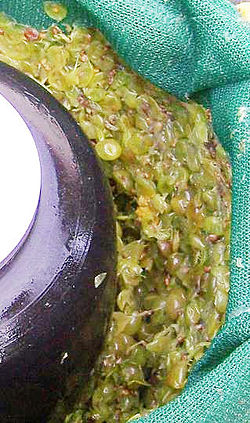果渣
此条目翻译品质不佳。 (2022年3月14日) |

果渣(Pomace)是指植物的果实在经过压榨,以提取其汁液或油份之后,所余下的固态部分,包括有果皮、果肉、果籽、果梗等。常见的水果有:葡萄、橄榄等。一般来说,果渣都没有特别作用,只有丢弃或保留作堆肥及饲料之用,但亦有部分植物的果渣,透过蒸馏、发酵或化学处理的加工,可再生产其他农产品。举例说:棕榈仁油及橄榄渣油都属于此类从果渣再提炼出来的农产品;果醋也一般采用果渣而非果汁或果肉来制作。
历史
[编辑]在中世纪时期的欧洲,由果渣发酵制成的,含有约3-4%酒精浓度的果渣酒十分普遍。 这种酒的制作十分简单:把水加进果渣,然后等待发酵。一般来讲,中世纪时期的酒不会为了提高酒的干度而发酵,所以即使在发酵后,果渣依然能够保留相当分量的残余糖分。
酸酒
[编辑]相传这种酿酒方式源于古希腊和古罗马帝国时的酸酒(Piquette):当时的奴隶把压过两次的果渣浸进水里一整天,才作第三次压榨,再把压出来的液体混和更多的水分制作[1]。这种酸酒是一种很低劣的酒,直到现在,“Piquette”这个名词依然可以解作“劣等酒”。
用途
[编辑]- 苹果酒:由苹果果渣发酵而成的酒。
- 樱桃力娇酒:樱桃果渣蒸馏后加入果酒原液及糖浆制成的力娇酒。
- 拉克酒:南欧和巴尔干地区出产的果渣蒸馏酒。
- 橄榄果渣油
- 笃斯越橘醋:利用笃斯越橘榨汁后留下的果渣酿制的果醋,营养丰富,可以调节代谢平衡。
酿酒
[编辑]葡萄渣酒
[编辑]视乎所采用的葡萄种类,由于生产流程的分别,白酒或红酒的酿造方法略有不同。
渣酿白兰地就是一种源自于意大利北部,从白葡萄酒的果渣蒸馏出来的酒液酿制,含有的残留果糖比单宁及酒精还要高[2]。
以下是各个国家的渣酿白兰地的名称:
- 法国的Marc
- 德国的Tresterbrand
- 俄罗斯的Kislyarka
- 乔治亚的恰恰(Chacha)
- 阿尔巴尼亚的 Raki e Rushi
- 保加利亚的拉基亚(Rakia)
- 波斯尼亚、克罗地亚、塞尔维亚及蒙特利哥罗的 komovica
- 匈牙利的törkölypálinka
- 罗马利亚的tescovină
- 斯洛伐克的terkelica
- 斯洛文尼亚的Tropinovec
- 意大利的grappa
- 希腊的tsipouro
- 克里特的tsikoudia
- 马其顿的комова
- 塞浦路斯的 zivania
- 黎巴嫩、巴勒斯坦及叙利亚的亚力酒(araq/arak)
- 西班牙的orujo
- 葡萄牙的aguardente和Bagaceira
- 墨西哥的Presidente
- 秘鲁及智利的皮斯可(Pisco)
- 玻利维亚的Singani
其他用途
[编辑]A 2004 study conducted by Erciyes University in Turkey found that pomace can also act as a natural food preservative that interferes with E. coli, Salmonella and Staphylococcus bacteria. Researchers pulverised the dried pomace from the white Turkish wine grape Emir Karasi and red Kalecik Karasi grapes; this was mixed with ethyl acetate, methanol or water and exposed to 14 different types of food bacteria. All 14 bacteria were inhibited to some degree by the pomace — depending on the grape variety and the concentration of the extract. The red wine Kalecik Karasi grape was the most effective; the researchers believed this was due to the higher concentration of polyphenols in red wine grape skins.[3]
Oenocyanin, a natural red dye and food-coloring agent, is produced from grape pomace. Tartrates (potassium bitartrate, 'cream of tartar') and grape polyphenols can also be manufactured from grape pomace.[2]。 可口可乐公司的品牌之一芬达相传就是在纳綷德国对所有来自其敌对国家美国的产品实施禁制令之后,可口可乐在德国的分公司利用当地仅有的材料而开发出来的碳酸饮料,当中就有利用果渣来制作梳打水。
参考资料
[编辑]- ^ Robinson, Jancis (ed.). The Oxford Companion to Wine Third. : 532.
- ^ 2.0 2.1 Robinson, Jancis (ed.). The Oxford Companion to Wine Third. Oxford: Oxford University Press. 2006: 534–535. ISBN 0-19-860990-6.
- ^ Gaffney, Jacob. What a Waste! Grape Pomace Kills Food-Spoiling Bacteria. Wine Spectator. September 23, 2004 [2013-08-14]. (原始内容存档于2016-03-03).
延伸阅读
[编辑]- Crowe, Alison. The Pomace Predicament. WineMaker. Aug/Sept 2005. (原始内容存档于2010-01-25).
- Hang, Y. D.; Woodams, E. E. Grape pomace: A novel substrate for microbial production of citric acid. Biotechnology Letters. April 1985, 7 (4): 253–254. doi:10.1007/BF01042372.[永久失效链接]


